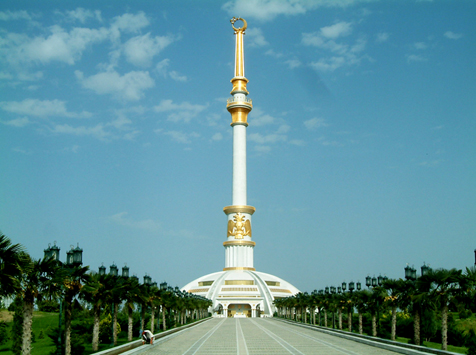turkmenistan
Oasis of Merv (40 km east of Mary) is one of the most ancient
regions of Central Asia.
Irrigation
was mastered
in Mary and the first traces of
irrigation systems in these areas relate to the period of the
Bronze Age. No wonder that there grew up one of the largest
cities in the ancient world - Merv (Margush, Margiana, or Moura
Maru in different sources). The
origin of Merv
is shrouded in mystery, one thing is certain - the first written
mention of Mary
appears in the Avesta chronicles about
the VIII-VI centuries BC. Omar
Khayyam, Al-Samani, Imamad Din Isfahani
and other great thinkers of the
middle ages
lived and worked here.
Sights of Merv
Today's ruins include at least five of ancient settlements - Erk Kala, Gyaur Kala, Sultan Kala, Abdullahan Kala and Bayramalihan Kala, and the ruins of the walled fortifications and other places of worship. The exact boundaries of the city are still not known. Most of them are heavily damaged, leaving only some of the strongly swollen earthen hills, but Merv continues to be one of the most unique monuments of history. Today it is included in UNESCO World Heritage List as the most well-preserved ancient center of the Silk Road.
Among the most interesting monuments of history can be noted mausoleum of Sultan Sanjar Dar al-Ahira (1140.), citadel Shazriar-Ark, the ruins of the walls of Abdullahan Kala (XV century), ruins of fortress and towers of Bayramalihan-Kala, ruins Kiz Kala fortress (VI-VII centuries), the mausoleums of Al-Hakim ibn Amir al-Jaafari and Buraydah ibn al-Husayn al-Islami (XV century, a place of pilgrimage), the mausoleum of Muhammad Ibn Zayd (XII century), a complex Talhatan Baba with mausoleums of Talhatan Baba, Imam Qasim, Imam Shafi and Imam Bakr Seljuk era, the mosque of Yusuf Hamadani (XIII century, the modern reconstruction made in the XIX century), ruins of Erk Kala (VI c), the ruins of a Christian church and a Buddhist monastery in Gyaur Kala (ancient Antioch Margiana), the ruins of a mosque Beni Makhan ("Friday Mosque", VII-XII centuries.), high walls of the fortress-like buildings and large Little Kiz Kala, mausoleum Kiz Bibi, as well as numerous remains of baths, palaces and ceremonial halls and other facilities.
Also noteworthy mausoleum mosque Dandankan and Talhatan Baba (XII century, 30 km south-east of Merv), keshk (fortified house) Akuyli-Koushuk (IX-XIII cc.), a single castle-Haram Keshk (7 km north of Gyaur Kala, IX-XIII cc.) Settlement Durnali (25 km north of Gyaur Kala, I-II cent.) Gebekly settlement (32 km north-west Gyaur Kala). Many archaeological finds discovered during excavations of ancient cities, now exhibited in the beautiful United Museum of Merv.












